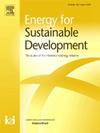Techno-economic insights on solar PV + storage in Small Island States (SIDS): Evidence from Trinidad and Tobago
IF 4.9
2区 工程技术
Q2 ENERGY & FUELS
引用次数: 0
Abstract
Small Island Developing States (SIDS) struggle with high electricity costs, fossil fuel dependence, and climate-related supply risks, yet empirical cost data for solar PV plus battery storage remain limited. This study addresses that gap using competitive tender prices and detailed PVsyst performance simulations from six recently commissioned grid-connected hybrid systems in Trinidad and Tobago (2–10 kW PV; 15–30 kWh storage). Results highlight pronounced economies of scale, with system size expansion from 2 kW to 10 kW reducing the levelised cost of electricity (LCOE) from US$0.694/kWh to US$0.191/kWh (−72 %) and levelised cost of storage (LCOS) from US$0.284/kWh to US$0.186/kWh (−34 %). Marginal abatement costs simultaneously decrease from US$211 to US$66 per tonne CO₂, reflecting substantially improved environmental returns with increased system scale. Lead-acid batteries offer lower upfront costs; however, lithium-ion storage approaches cost parity at system capacities of 5 kW or greater due to superior cycle life and utilisation characteristics. Despite these improvements, the resulting costs remain significantly above global benchmarks, highlighting structural economic and logistical challenges specific to SIDS contexts. Key policy recommendations include aggregating rooftops into optimally sized installations (8–10 kW), deploying targeted green financing mechanisms, and introducing dual-rate net billing tariffs coupled with storage rebates. Implementing these policies can significantly reduce unit costs, narrowing the gap with global benchmarks, and provide a replicable framework for sustainable renewable energy deployment and carbon mitigation in SIDS.
小岛屿国家太阳能光伏+储能的技术经济见解:来自特立尼达和多巴哥的证据
小岛屿发展中国家(SIDS)面临着高昂的电力成本、对化石燃料的依赖以及与气候相关的供应风险,但太阳能光伏+电池储能的经验成本数据仍然有限。本研究通过竞争性招标价格和特立尼达和多巴哥最近投入使用的六个并网混合系统(2-10千瓦光伏;15-30千瓦时储能)的详细PV系统性能模拟来解决这一差距。结果突出了显著的规模经济,系统规模从2千瓦扩展到10千瓦,将平化电力成本(LCOE)从0.694美元/千瓦时降低到0.191美元/千瓦时(- 72%),将平化存储成本(LCOS)从0.284美元/千瓦时降低到0.186美元/千瓦时(- 34%)。边际减排成本同时从每吨二氧化碳211美元降至66美元,反映出随着系统规模的扩大,环境回报大幅改善。铅酸电池的前期成本较低;然而,由于优越的循环寿命和利用特性,锂离子存储在5千瓦或更大的系统容量下接近成本平价。尽管有这些改进,但由此产生的费用仍然大大高于全球基准,突出了小岛屿发展中国家特有的结构性经济和后勤挑战。关键的政策建议包括将屋顶聚集成最佳规模的装置(8-10千瓦),部署有针对性的绿色融资机制,以及引入双费率净计费关税和储能回扣。实施这些政策可以大大降低单位成本,缩小与全球基准的差距,并为小岛屿发展中国家的可持续可再生能源部署和碳减排提供可复制的框架。
本文章由计算机程序翻译,如有差异,请以英文原文为准。
求助全文
约1分钟内获得全文
求助全文
来源期刊

Energy for Sustainable Development
ENERGY & FUELS-ENERGY & FUELS
CiteScore
8.10
自引率
9.10%
发文量
187
审稿时长
6-12 weeks
期刊介绍:
Published on behalf of the International Energy Initiative, Energy for Sustainable Development is the journal for decision makers, managers, consultants, policy makers, planners and researchers in both government and non-government organizations. It publishes original research and reviews about energy in developing countries, sustainable development, energy resources, technologies, policies and interactions.
 求助内容:
求助内容: 应助结果提醒方式:
应助结果提醒方式:


